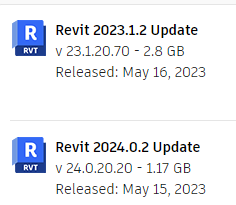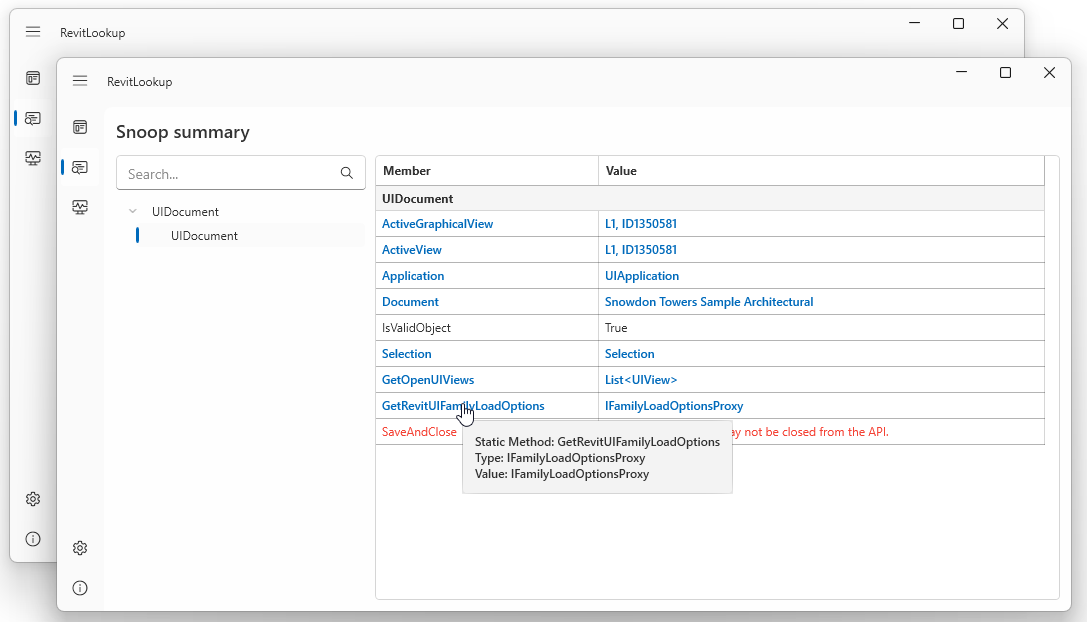64 Bit Ids, Revit and RevitLookup Updates
Important updates to both Revit and RevitLookup, and other interesting news:
- Revit X.Y.2 updates
- RevitLookup 2024.0.5
- Backward compatible 64 bit element id
- 15-minute cities
- Cloud data carbon footprint
- Live annotated
httpsrequest log
Revit X.Y.2 Updates
Update number 2 has been released for both Revit 2023 and 2024, Revit 2023.1.2 and Revit 2024.0.2, respectively:

As usual, they can be obtained from manage.autodesk.com.
RevitLookup 2024.0.5
RevitLookup also sports a new update, release 2024.0.5. Here is a list of all updates and their enhancements since the initial 2024 release:
-
Static members support: RevitLookup now supports the display of these and other properties and methods:
Category.GetCategory(); Document.GetDocumentVersion() UIDocument.GetRevitUIFamilyLoadOptions() Application.MinimumThickness

-
Ribbon update: SplitButton replaced by PullDownButton. Thanks for voting!

-
Other improvements:
- Added DefinitionGroup support
- Added Element.GetMaterialArea support
- Added Element.GetMaterialVolume support
- Added FamilyInstance.get_Room support
- Added FamilyInstance.get_ToRoom support
- Added FamilyInstance.get_FromRoom support
- "Show element" is no longer available for ElementType
- Bugs:
- Fixed issue when GetMaterialIds method didn't return nonPaint materials #163
- RevitLookup 2024.0.4:
- Improvements:
- Added Workset support
- Added WorksetTable support
- Added Document.GetUnusedElements support
- Bugs:
- Fixed Dashboard window startup location
- Improvements:
- RevitLookup 2024.0.2:
- Bugs:
- Fixed Fatal Error on Windows 10 https://github.com/jeremytammik/RevitLookup/issues/153 Accent colour sync with OS now only available in Windows 11 and above. Many thanks to Aleksey Negus for testing builds
- Bugs:
- RevitLookup 2024.0.1:
- Major changes:
- Added option to enable hardware acceleration (experimental)
- Added button to enable RevitLookup panel on Modify tab by @ricaun in #152 Disabled by default. Thanks vor voting!
- Opening RevitLookup window only when the Revit runtime context is available https://github.com/jeremytammik/RevitLookup/issues/155
- Improvements:
- Added shortcuts support for the Modify tab https://github.com/jeremytammik/RevitLookup/issues/150
- Added EvaluatedParameter support
- Added Category.get_Visible support
- Added Category.get_AllowsVisibilityControl support
- Added Category.GetLineWeight support
- Added Category.GetLinePatternId support
- Added Category.GetElements extension
- Added Reference.ConvertToStableRepresentation support
- Bugs:
- Fixed rare crashes in EventMonitor on large models
- Fixed Curve.Evaluate resolver using EndParameter as values
- Other:
- Added installers for previous RevitLookup versions https://github.com/jeremytammik/RevitLookup/wiki/Versions
- Major changes:
Ever so many thanks to Luiz Henrique @ricaun Cassettari and above all to Roman Nice3point for this impressive list of enhancements, with extra kudos to Roman for all the RevitLookup maintenance work!
Backward Compatible 64 Bit Element Id
Richard RPThomas108 Thomas
shares code for handling ElementId 64 bit backward compatibility in the thread
on upgrade 2024 API causing schema error,
explaining:
The change to
Int64should be transparent for most situations; there is a design decision some developers will need to consider in terms of how theElementIdIntegerValueproperty is replaced with the oldValue. I decided it was better to update backwards the base code with an extension methodElementId.Value. Can't do much about the constructor, however:
Module RT_ElementIdExtensionModule
#If RvtVer >= 2024 Then
<Extension>
Public Function NewElementId(L As Long) As ElementId
Return New ElementId(L)
End Function
#Else
<Extension>
Public Function Value(ID As ElementId) As Long
Return ID.IntegerValue
End Function
<Extension>
Public Function NewElementId(L As Long) As ElementId
If L > Int32.MaxValue OrElse L < Int32.MinValue Then
Throw New OverflowException("Value for ElementId out of range.")
End If
Return New ElementId(CInt(L))
End Function
#End If
End Module
Many thanks to Richard for sharing this approach.
15-Minute Cities
I just noticed Kean Walmsley's nice discussion of 15-minute cities, 20-minute neighbourhoods and 30-second offices.
Cloud Data Carbon Footprint
You have probably seen hundreds if not thousands of email footers reminding you not to print every email you receive on paper.
Now the time has come to add a reminder not to save ever bit of information you receive digitally either.
Apparently, storing 100 GB of data in the cloud results in a carbon footprint of about 0.2 tons of CO2 per year.
That is about the same as:
- Burning 45 kg of coal
- Driving a car for approximately 965 km
- The production of about 1,000 plastic bags
Live Annotated Https Request Log
Talking about bits stored in the cloud, here is a neat web page that enables you to see this page fetch itself, byte by byte, over TLS:
This page performs a live, annotated
https:request for its own source.